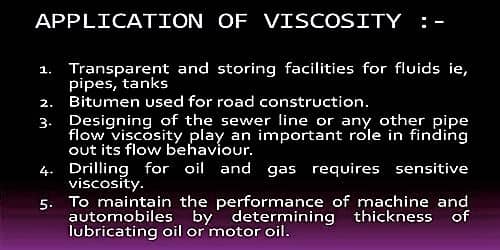Viscosity is like a frictional force. It is an essential property of fluids which describes a liquids confrontation to flow and is related to the inner friction within the fluid. The viscosity of liquids is a significant property that must be measured accurately in some industries. For example, the viscosity of paints, varnishes, and comparable domestic products is intimately regulated so that the paints and varnishes can be applied smoothly and evenly with a brush roller. It is principally just another force inside the liquid, easily familiar and hence has been in common practice without any larger significance.
The importance of viscosity can be understood from the following examples –
(i) The knowledge of the coefficient of viscosity of organic liquids is used to determine their molecular weights.
(ii) The knowledge of the coefficient of viscosity and its variation with temperature helps us to choose a suitable lubricant for specific machines. In light machinery thin oils (for example, lubricant oil used in clocks) with low viscosity is used. In heavy machinery, highly viscous oils (example: grease) are used. In lubrication, viscosity is the most significant characteristic of lubricating oils and, what is often forgotten, it is also very vital in greases. Viscosity is the resistance to movement. Water flows fast so it has low viscosity, honey has a high viscosity.
(iii) The viscosity of a few medications, such as the various liquids used to remove warts, has also been modified for easier application. Drug companies manufacture medicines, such as cough syrup, that have a high viscosity yet are still drinkable, in order to coat the throat.
(iv) The viscosity of paints, varnishes, and comparable household products is closely regulated so that the paints and varnishes can be applied smoothly and evenly with a brush roller.
(v) Viscosity plays a considerable function in the preparation and serving of food. Cooking oils may or may not change viscosity as they heat, while many become much more viscous as they cool. Fats, which are reasonably viscous when heated, become solid when chilled.
(vi) Manufacturing equipment requires suitable lubrication to run effortlessly. Lubricants that are too viscous can jam and clog pipelines. Lubricants that are too thin present too little protection for moving parts.
(vii) The viscosity of coatings is one of the key parameters that determine the achievement of the coating procedure. Because the repeatability and reproducibility of the coating procedure are often closely linked to the coating’s viscosity, it is a key parameter to control.
Real- life applications of liquid with low viscosity:
- One example is brake fluid. Brake fluid transmits force through the braking system, and it would not operate properly if it had a different viscosity,
- Gum that we use are highly viscous, to hold mating part before powerfully before sticking action complete,
- Lubricants for machine systems also work the way they do in part as a result of their viscosity,
- using coolant while machining at lathe shops,
- petrol (as a cleaner) being used in mobile shops.
Viscosity measurements of cosmetics are often performed for shelf-life testing to find out constancy. Viscosity measurements are a significant instrument for a receptive determine of material changes. Many of the formulations are complex emulsions with structures that vary over time and may be reflected in viscosity changes.









